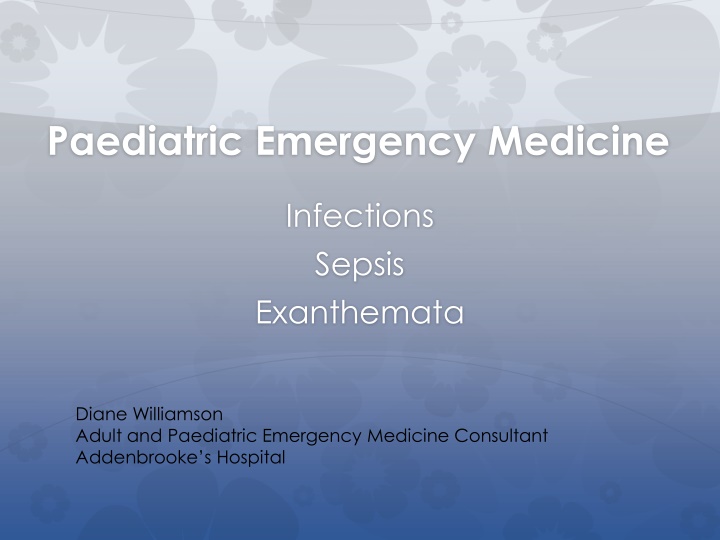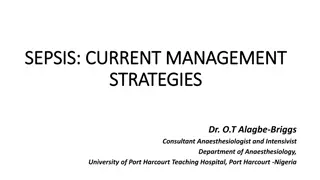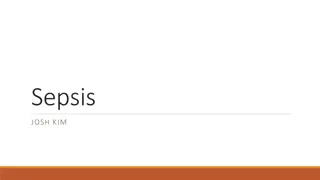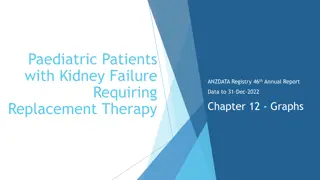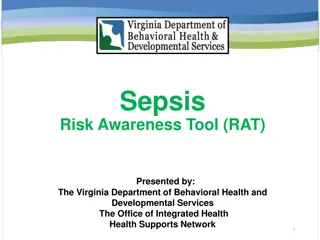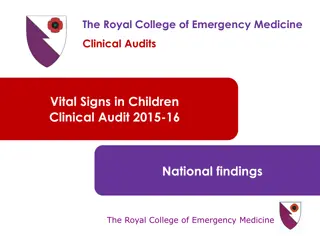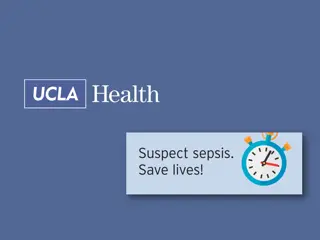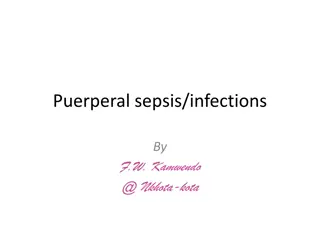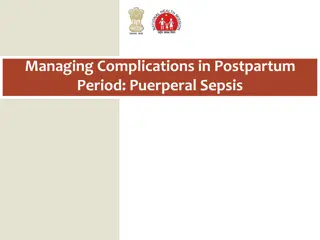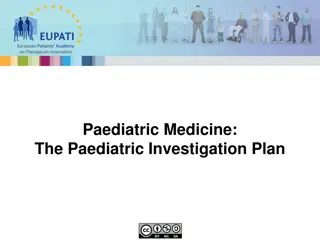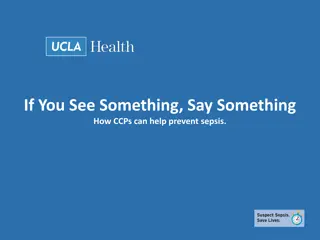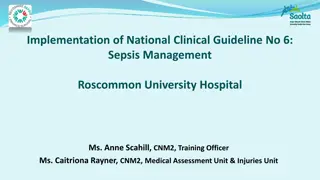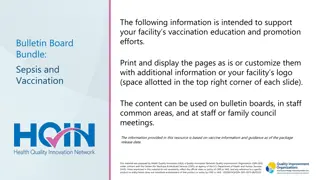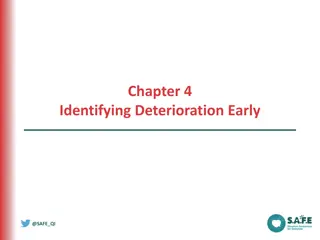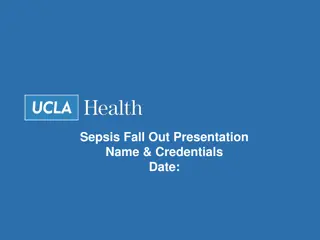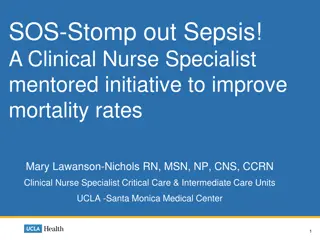Paediatric Emergency Medicine Overview: Infections, Sepsis, Exanthemata, and Warning Signs
Paediatric emergency medicine involves assessing and managing various conditions in children, such as infections, sepsis, and exanthemata. This overview covers the evaluation of febrile children, warning signs indicating potential serious illness, and the importance of thorough examination and assessment. Key aspects include recognizing signs of dehydration, identifying the focus of infection, and considering the child's social and travel background.
Download Presentation

Please find below an Image/Link to download the presentation.
The content on the website is provided AS IS for your information and personal use only. It may not be sold, licensed, or shared on other websites without obtaining consent from the author.If you encounter any issues during the download, it is possible that the publisher has removed the file from their server.
You are allowed to download the files provided on this website for personal or commercial use, subject to the condition that they are used lawfully. All files are the property of their respective owners.
The content on the website is provided AS IS for your information and personal use only. It may not be sold, licensed, or shared on other websites without obtaining consent from the author.
E N D
Presentation Transcript
Paediatric Emergency Medicine Infections Sepsis Exanthemata Diane Williamson Adult and Paediatric Emergency Medicine Consultant Addenbrooke s Hospital
Outline Fever Infections Exanthemata Sepsis Other advice questions
Noah 9 month old child, with Mother Cough and runny nose x 2 days Fever up to 39 degrees Not eating, bit miserable, still playing What else do you want to know? What will you look for on examination?
Noah HR 120, RR 30, T38 degrees, CR <2 seconds Alert, smiling, interested in surroundings Examination ENT - Coryzal, red throat, TM pink but not bulging Resp - No respiratory distress, chest clear CVS - Well hydrated, CR <2s, HS normal Abdomen soft and not tender No rash
What will you do? What advice will you give?
Noah Returns Persistent fever and now vomiting More sleepy than usual Only fed 2oz milk this morning What else do you want to know? What will you look for on examination?
Noah HR 180, Sats 94% air, RR 50 Lethargic, cool hands and feet AB intact C - Capillary refill 4 seconds D - Lethargic, drowsy E - Mottled limbs and torso What will you do?
Assessing febrile children Assess for life-threatening signs ABCDE Look for evidence of serious illness Assess for signs of dehydration Consider - where is focus of infection? Do they need investigations? Don t forget travel Consider social situation
Warning Signs First impressions matter Reduced level of consciousness Pale or mottled Grunting, moderate or severe indrawing
Warning Signs Examination Tachycardia (out of proportion to fever, crying ) Prolonged capillary refill Cold hands and feet Non-blanching rash
Investigations Focus on the focus Urine dip CXR FBC, CRP, Blood culture LP in young babies or if signs of meningitis Remember the social history If recent travel to malarial area ALWAYS do malaria screen and repeat if negative
Management Refer if there are any concerning features and no diagnosis made, or ANY red features Often a period of observation is the most helpful investigation go back and reassess If sending home, give good discharge advice and safety net Never send home a child you are worried about or with with persistent tachycardia
Discharge Advice Antipyretics Encourage fluids Signs of dehydration (sunken fontanelle, dry mouth, no tears, overall lethargy) How to identify a non-blanching rash To keep the child out of school or nursery until the fever resolves To seek review if >5 days of fever, fit, non-blanching rash, if they are more worried than when they last sought advice
The Diagnostic Matrix Evidence: Positive Looks Well Looks Unwell Evidence: Negative Thanks to: Damian Roland, Honorary Senior Lecturer at University of Leicester
When is it Sepsis? Investigations: Sepsis positive Looks Well Looks Unwell Investigations: Sepsis negative Thanks to: Damian Roland, Honorary Senior Lecturer at University of Leicester
Sepsis Worldwide, sepsis causes 60% of deaths in children under 5 years US Data Fatality Rate of children with sepsis 10% Incidence per 2000 children Neonatal < 1 year 1 to 19 years 20 4 1 Sepsis in Children Plunkett and Tong The BMJ 13 June 2015
Risk Factors <3 months Co-morbidity (e.g. congenital heart disease, diabetes, neuromuscular disease, ex-prem) Social concern
Sepsis presentations are non-specific Suspect sepsis in the infant or child with Temp <36 or >38.5 Tachycardia (or bradycardia in infants <1 year) Tachypnea High or low WBC Beware of fever with limb pain Beware of the blanching rash
Management The golden hour - be prepared! Oxygen (SaO2 >94%) Access IV or IO Bloods cultures, FBC, CRP, VBG, glucose Treat hypoglycaemia 2ml/kg of 10% glucose Fluid resuscitation 20ml/kg in 5 min, review and repeat Inotropes (adrenaline or dopamine) Antibiotics Investigations lactate, urinalysis, throat swab Refer
Exanthemata Rash Illnesses
Chicken Pox Varicella zoster virus ds DNA alphaherpesvirinae Airborne resp droplets and direct via vesicles 90% of cases <10 years of age Incubation 10 21 days Crops of itchy vesicular lesions Consider acyclovir for at risk
Measles Morbillivirus, family Paramyxoviridae, RNA virus Incubation 7 10 days after exposure High fever, malaise, anorexia x 4-7 days Classic triad: conjunctivitis, cough, coryza Koplik spots ( grains of sand on red base on buccal mucosa opposite second molars) are pathognomic Blanching, eythematous maculopapular rash
Measles Consider immunity of child and family Consider immune globulin within 6 days of exposure in unimmunised or at risk Avoid live virus vaccine in immunocompromised Lab diagnosis: IgM and IgG titres, isolation of virus, PCR Report Complications croup, encephalitis (10% mortality), pneumonia, SSPE
Fifth Disease Erythema Infectiosum Parvovirus B19, an erythrovirus Incubation 1 week Mild prodrome headache, fever, sore throat 7 - 10 day symptom-free period Slapped cheek phase can be prolonged
Roseola infantum Human herpesvirus (HHV-6) Respiratory transmission 9 12 month infant Acute onset high fever x 3 4 days Rash appears late Benign in immune competent but remains latent and is a major cause of morbidity and mortality in immunocompromised e.g. HIV, organ transplant
Rubella Rubella virus, encapsulated ssRNA virus Respiratory transmission Incubation 14 21 days Malaise, conjunctivitis, sore throat 5 days prior to onset of rash Enquire about contact immunity congenital rubella is a risk
Scarlet Fever Group A beta-haemolytic streptococcus Respiratory droplets Incubation 12 hours to 7 days Age 1 to 10 years Usual focus is tonsils, consider skin Exudative pharyngitis, fever, exanthem Complications: peritonsillar abscess, sinusitis, pneumonia, rheumatic fever, glomerulonephritis, septic shock Penicillin
Kawasaki Acute, febrile, vasculitic syndrome Fever >5 days plus: Conjunctivitis Strawberry tongue, lip fissures Erythema and oedema of hands Lymphadenopathy Rash groin or extremities Refer for investigation and management Complication: coronary artery aneurysm
Hand, Foot Mouth Coxsackie A type 16 and others, enterovirus Malaise, sore throat, fever Macular lesions on buccal mucosa, hands, feet and genitalia become vesicular and erode Symptomatic management Complications: Encephalitis, Guillain-Barre, transverse myelitis Viral culture, PCR
Herpes simplex Herpesviridae, HSV-1 and HSV-2, dsDNA virus Incubation 3 6 days Abrupt onset fever, painful gingivitis, vesicular lesions, lymphadenopathy Viral shedding x 3 weeks Aciclovir Primary infection, latency and reactivation Dissemination in immunocompromised
Henoch Schonlein Purpura Immunoglobulin mediated vasculitis Prodrome - headache, anorexia, fever Rash, abdominal pain, vomiting, joint pain Bloody stool, scrotal oedema Investigations FBC, renal function, coagulation Management hydration, analgesia, discontinue possible causative drugs Refer
Meningococcal Disease Suspect Recognise Sepsis management
Impetigo Staphylococcus, streptococcus Golden crust on existing lesion Spreading, contagious by contact Flucloxacillin, co-amoxiclav Culture if resistant Hand hygiene advice
Erysipelas Streptococcus, staphylococcus Spreading, painful, indurating rash Risk of systemic sepsis Penicillin, consider ceftriaxone Refer and seek Microbiology advice
Urticaria Etiology is diverse allergy, idiopathic Migratory, blanching, coalescing, erythematous rash Increases when skin is warm Antihistamine Avoid provoking factors Reassurance
Non-accidental injury Get the history Consider social concerns Consider other children at risk Complete safeguarding and Paediatric referral
